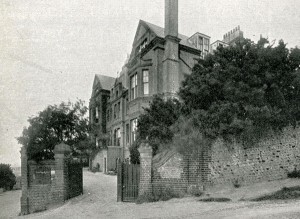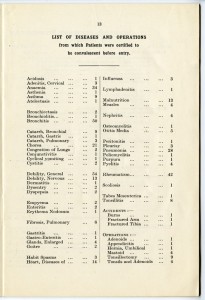The Children’s Society has run several children’s convalescent homes over the years. These were homes that specialised in medical care for children and young people. Generally, children were transferred to these homes when they needed more medical care than normal but didn’t need to stay in a hospital. In other cases, the convalescent homes looked after children who had been in hospital for an operation and were now recovering.
One such convalescent home was St John’s Home in Kemp Town, Brighton, Sussex, which was large enough to look after around 80 children. This home wasn’t originally run by The Children’s Society. It was opened in 1875 as an independent home by Sister Jane Borradaile.
An annual report from 1937 gives more information about the home:
Built on an ideal site on the Downs about 230ft. above sea level, and yet within ten minutes’ walk of the sea, which is seen from most of the windows; the expansive views of sea, sky and country have a most exhilarating effect, and the result of such an environment is quickly seen in the generally rapid improvement in the health of the patients.
Later, the same report says:
Most of the children who come to us, arrive looking ill and miserable, and it is an unending source of wonder and pleasure to see the often rapid, and generally steady improvement shown after the first few days. Every child is medically examined on admission, and is kept under Medical observation during the whole convalescence. Many grateful letters are received from their parents who often keep in touch with the home for years.
Sister Jane Borradaile died in 1918 and she entrusted the management of the home to the Sisters of the Community of the Holy Cross, Haywards Heath, Sussex. From 1921 onwards the Community appointed Sister Helena Mary to run the home.
In 1938, Sister Helena Mary had to stand down due to health reasons and the Community of the Holy Cross found that they weren’t able to replace her. Instead, the home was transferred to The Children’s Society (then known as the Waifs and Strays Society) as its new trustees.
St John’s Home appeared to have had links to the Waifs and Strays Society for several decades before it came under The Society’s management. Looking through the children’s case files from the Waifs and Strays Society before 1938, we see lots of children being transferred to St John’s Home for treatment when they became unwell.
Once St John’s Home was taken over by its new trustees, things appear to have continued as before, with children staying at the home to recover from operations and medical conditions. There was a brief interlude during the Second World War when the children and staff were evacuated to a building in Itchingfield, Sussex. This evacuated home ran from 1941 to 1945, at which point the home returned to Kemp Town in Brighton.
For over ten more years, St John’s continued as a convalescent home. Then in 1957 it was converted by The Children’s Society into a school for disabled children, with places for 55 children over the age of seven. This school ran for around five years. We don’t know the exact date, but it seems as if the school closed in the early 1960s. All in all, St John’s had looked after children for around 90 years.
The records of St John’s Home and the case files for children staying at the home are a great resource for learning about prevalent medical conditions and medical treatments throughout the course of the home’s lifetime. For example, the annual reports for St John’s Home list all of the conditions that the children in the home were convalescing from that year. The below list of conditions comes from the 1937 annual report and shows that common conditions in the home that year included bronchitis, rheumatism, anaemia and pneumonia (click the image to see a larger version):
For more information, see the history of St John’s as an independent home and the history of St John’s once taken over by The Children’s Society.



As an amateur archivist searching the web for collectible ‘social history memorabilia’ I have noted the extraordinary glut of pictorial reference for sale on the likes of ‘Ebay et al online’ portrayed in Victorian and Edwardian gravure print, photo real or the more exquisitely printed chromolithograph prints of multiple overlaid colours on (e.g.) period ha-penny posted postcards…
There’s rabid commercial vultures out there eyeing from some ragged vantage auctions or other seedy sale old volumes of archival prints and photo albums all too ready to swoop down from their lofty businesslike peaks to tear page-by-page out of aged-family-libraries an individual print to sell for a fortune the volume or album was bid on for a pittance.
Dear Bobbie,
I agree that it’s sad to see collections and volumes broken up for sale.
The sales team at the National Archives monitors auctions and online sales of archives. If you ever see anything that shouldn’t legally be for sale or anything that would benefit from going to a set archive, it might be worth getting in contact with them. (More information on the sales team can be found here: http://www.nationalarchives.gov.uk/archives-sector/cultural-property.htm)
Janine